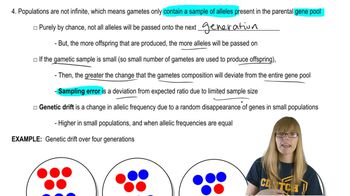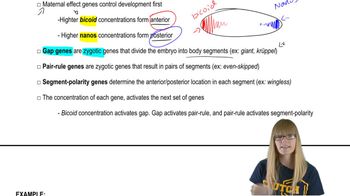Describe how selection at a locus can result in a loss of polymorphism surrounding the locus.
Table of contents
- 1. Introduction to Genetics51m
- 2. Mendel's Laws of Inheritance3h 37m
- 3. Extensions to Mendelian Inheritance2h 41m
- 4. Genetic Mapping and Linkage2h 28m
- 5. Genetics of Bacteria and Viruses1h 21m
- 6. Chromosomal Variation1h 48m
- 7. DNA and Chromosome Structure56m
- 8. DNA Replication1h 10m
- 9. Mitosis and Meiosis1h 34m
- 10. Transcription1h 0m
- 11. Translation58m
- 12. Gene Regulation in Prokaryotes1h 19m
- 13. Gene Regulation in Eukaryotes44m
- 14. Genetic Control of Development44m
- 15. Genomes and Genomics1h 50m
- 16. Transposable Elements47m
- 17. Mutation, Repair, and Recombination1h 6m
- 18. Molecular Genetic Tools19m
- 19. Cancer Genetics29m
- 20. Quantitative Genetics1h 26m
- 21. Population Genetics50m
- 22. Evolutionary Genetics29m
22. Evolutionary Genetics
Phylogenetic Trees
Problem D.12
Textbook Question
A 9-bp deletion in the mitochondrial genome between the gene for cytochrome oxidase subunit II and the gene for tRNAᴸʸˢ is a common polymorphism among Polynesians and also in a population of Taiwanese natives. The frequency of the polymorphism varies between populations: The highest frequency is seen in the Maoris of New Zealand (98%), lower levels are seen in eastern Polynesia (80%) and western Polynesia (89%), and the lowest level is seen in the Taiwanese population. What do these frequencies tell us about the settlement of the Pacific by the ancestors of the present-day Polynesians?
 Verified step by step guidance
Verified step by step guidance1
Step 1: Understand the genetic marker involved — a 9-bp deletion in the mitochondrial DNA (mtDNA) located between the cytochrome oxidase subunit II gene and the tRNAᴸʸˢ gene. Since mtDNA is maternally inherited and does not recombine, it is useful for tracing maternal lineage and population history.
Step 2: Note the frequencies of this polymorphism in different populations: very high in Maoris (98%), high in eastern Polynesia (80%) and western Polynesia (89%), and lowest in Taiwanese natives. These frequencies represent how common this genetic variant is in each group.
Step 3: Interpret the gradient of frequencies geographically. Higher frequencies in Maoris and Polynesian populations compared to Taiwanese suggest a founder effect or genetic drift as populations migrated and settled across the Pacific. The decreasing frequency from Polynesia to Taiwan may indicate the direction and sequence of migration events.
Step 4: Use the concept of population genetics and migration to infer that the ancestors of Polynesians likely originated from a population related to Taiwanese natives but experienced genetic changes (like the increase in this deletion frequency) as they moved eastward and settled the Pacific islands.
Step 5: Conclude that the distribution of this polymorphism supports a model of human migration where the Pacific was settled in a stepwise manner, with genetic drift and founder effects shaping the genetic diversity observed today among Polynesian populations.
 Verified video answer for a similar problem:
Verified video answer for a similar problem:This video solution was recommended by our tutors as helpful for the problem above
Video duration:
3mPlay a video:
Was this helpful?
Key Concepts
Here are the essential concepts you must grasp in order to answer the question correctly.
Mitochondrial DNA and Maternal Inheritance
Mitochondrial DNA (mtDNA) is inherited exclusively from the mother, making it a powerful tool for tracing maternal lineages and population history. Because mtDNA mutates relatively slowly and does not recombine, specific polymorphisms can indicate shared ancestry and migration patterns among populations.
Recommended video:
Guided course

Types of Maternal Inheritance
Population Genetics and Polymorphism Frequency
Polymorphism frequency refers to how common a genetic variant is within a population. Differences in frequency across populations can reveal historical relationships, gene flow, and founder effects. High frequency in one group and lower in others suggests a common origin followed by population divergence or migration.
Recommended video:
Guided course

Genetic Drift
Human Migration and Settlement Patterns in the Pacific
Genetic data, such as mtDNA polymorphisms, help reconstruct the migration routes and settlement history of Pacific peoples. Variations in genetic markers among Polynesian and Taiwanese populations provide evidence for the timing and pathways of ancestral movements across the Pacific islands.
Recommended video:
Guided course

Segmentation Genes
Related Videos
Related Practice
Textbook Question
368
views


